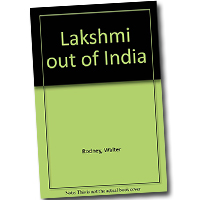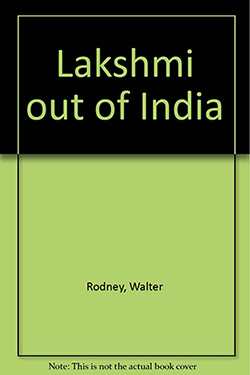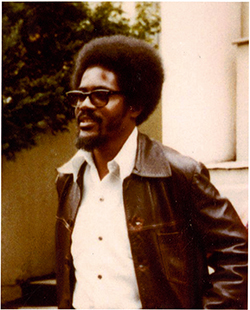Lakshmi Out of India
| By Walter Rodney | |
 |
LAKSHMI out of India is another gem of Guyanese literature. Primarily written targeting a children readership to entertain and educate, it is also a source document for research, and a way of extending the dialogue on the subject, especially through imaginative literature. It is not easy to secure all the pieces in this history; so, oftentimes, the missing pieces are fleshed out by our imaginative writers. As a source document, the Preface to the book declares that the author, Walter Rodney, “painstakingly checked …for accuracy…” and the “editors also made checks on place names, historical and other facts, and Hindi spellings in the text,” and no effort was spared in ensuring that “the story of Lakshmi’s life prior to her indentureship is rooted in an accurate historical geographical and cultural context.” However, to put the story of Lakshmi in context, it is useful to know how indentureship came into force. The plantation economy demanded an abundant and stable labour force. This brought on the proliferation of slavery. However, this system of enslavement came to an end in British Guiana in 1838. Emancipation led to a shortage of labour on the plantation. |
|
In order to counter this shortfall in labour, which would cause a shortfall in production and profit, the planters devised a system of importing labourers from India and other places. For persons coming from India to Guyana, indentureship started in 1838 and ended in 1917. Th The book ends on a somewhat beautiful and romantic note. Lakshmi was at the emigration depot, wavering in her decision whether or not to embark on the life-changing venture to go “to Demerara to work for a big wage.” It was her meeting with Prasad at the depot that helped her decide. The strange thing about Prasad was that instead of carrying a jahaji bandhar (georgie-bundle) of personal possessions, he had on him only a special type of drum, called the ‘dholak’, which was Lakshmi’s favourite musical instrument.
As mentioned before, the story is told in a series of flashbacks as a literary device. In chronological order, the story of Lakshmi out of India goes like this: The caste system plays a significant role in India. People of this caste were peasants and agricultural workers who formed the backbone of the country, according to the book, which explained the situation this way: Due to overpopulation, there was limited agricultural land. The agricultural land was mainly in the hands of the Zamindars, who exploited those who worked the land. So, the peasants were caught in a vicious cycle of poverty, as was the case of Lakshmi and her family. But life continued despite the poverty on one hand, and wealth on the other hand. Life continued because it was a society of rituals and customs; things that made life bearable. Some of the festivals that added colour and brightness to drab existence were Holi and Divali. Lakshmi loved those festival and other religious celebrations, because she became acquainted with the songs, rhymes and proverbs inherited from her ancestors. Life continued for children of the time, because of the games and pastimes that were really apprenticeship to real-life situations. For instance, the rains brought pools of water in which the children made play. They played with the earth, making mud dolls and other things of interest. This play in the mud led to the building of huts. Mud was the main building material for the people of Lakshmi’s time. The mud also encouraged art; the designing of earthen floors and earthen walls. The rains also brought springs of flowers, with craftsmen and women who make garlands. To some, garland making was a profession, and those garland makers were called malakara. The rains also brought a change in the life of Lakshmi. Life changed drastically for Lakshmi after The Great Floods of 1860. She lost her family, and was left destitute, having to seek shelter with her Chacha (father’s brother) and his family. With this family, she lived a life of misery for five years; so, when talk of emigration surfaced, it fired her imagination; it was a way of escape. And the recruiters were enticing, with their stories of riches in Demerara. And that’s how come she boarded the ship, ‘Clarence’, heading to British Guiana and a new way of life. Lakshmi out of India, according to the Preface, “is the second in a series of five books Walter Rodney had planned for the children of Guyana.” The first such book was Kofi Baadu out of Africa. The other proposed titles were Fung-A-Fat: Out of China, Adriaan Hendricks: Out of Holland, and Joao Gomes: Out of Madeira. This series of books was birthed “so that the children, at least, might better understand themselves and each other.” This book, Lakshmi out of India, has done just that and more in an entertaining and elucidating manner. |
|




 “Without stopping to think about it, Lakshmi began to sing softly when Prasad’s fingers spoke through the dholak.” Lakshmi and Prasad were married right there in the emigration office.
“Without stopping to think about it, Lakshmi began to sing softly when Prasad’s fingers spoke through the dholak.” Lakshmi and Prasad were married right there in the emigration office.














